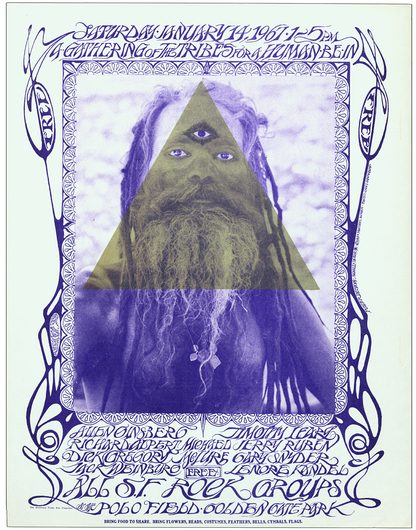
MOUSE, Stanley; KELLEY, Alton; BOWEN, Michael
Handbill for the Human Be-In
San Francisco, Bindwood Press, (1967). Handbill announcing "A Gathering of the Tribes for a Human Be-In" and listing some of the participants -- Allen Ginsberg, Gary Snyder, Jerry Rubin, Timothy Leary, Dick Gregory, "All SF Rock Groups," etc. along with the pertinent details: "Saturday Jan 14 1-5 P.M., Free, Polo Field, Golden Gate Park." The Human Be-In was conceived as another of the unstructured celebrations of the San Francisco hippie community, in the tradition of the earlier Trips Festival. The presence of a roster of superstar figures was intended to help draw out the largest possible crowd, but the star of the event was intended to be the crowd itself. Indeed, the speakers could not be heard much of the time but no one much cared. The bands played in the afternoon, and included Quicksilver Messenger Service, the Grateful Dead, Jefferson Airplane, Country Joe and the Fish, and others. After the sound system broke down at one point, it was announced that the generator would hereafter be guarded by the Hell's Angels. The event went smoothly: tens of thousands of people showed up, many smoking pot or tripping on LSD, but the police kept a low profile and didn't arrest any of the people openly smoking pot; a priest from the San Francisco Zen Temple meditated on stage throughout the day. At the end of the day, Gary Snyder blew a conch shell -- a traditional Japanese Buddhist ritual instrument -- and Allen Ginsberg led a Buddhist chant, at which point the crowd drifted apart. The Human Be-In became one of the milestone events of the emerging counterculture and, in retrospect, one of its high points. It succeeded for a time in bridging the gap between the San Francisco hippie culture and the Berkeley-based radical political movement, finding some common ground for the two -- a joining of two disparate, and sometimes divergent, movements that has had repercussions to the present day: today, cultural experimentation and alternative lifestyles go hand in hand with political critique, a trend that was considerably more uncommon prior to this occasion. There were several variant designs for the poster: this one was designed by Stanley Mouse, Alton Kelley and Michael Bowen and was the original poster design -- an image of an Indian swami with a third eye added by Mouse. The image was also used as the cover for issue number 5 of the Oracle, the San Francisco underground newspaper, which took on a decidedly more psychedelic look with this number, timed to coincide with the festival. Reportedly, Mouse wasn't especially happy with the design: he felt that the image of the Hindu holy man had been foisted on him, which helps explain the number of different posters for the event. Purple and gray on white. 8-1/2" x 11". Fine. (Jerry Rubin's last name is misspelled as "Ruben.") Scarce and ephemeral; it would seem that few of these have survived.
[#007954]
SOLD
All books are first printings of first editions or first American editions unless otherwise noted.